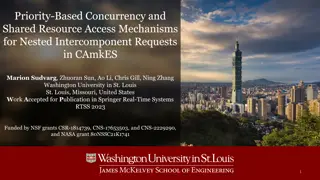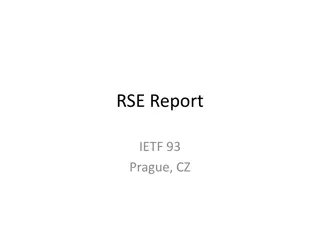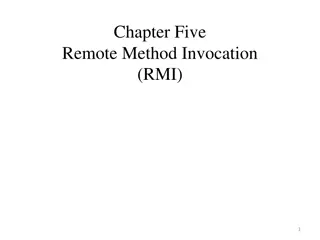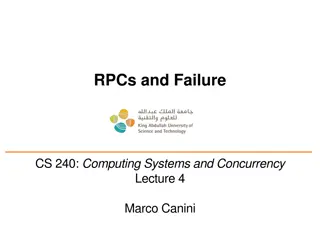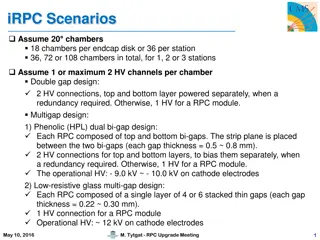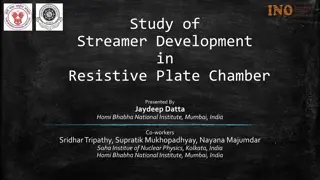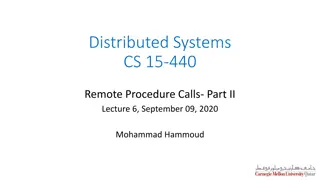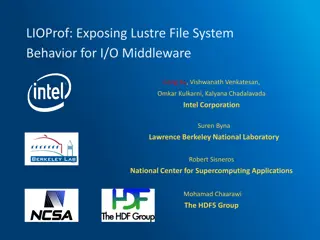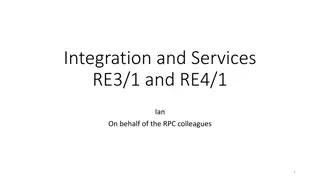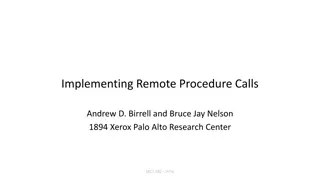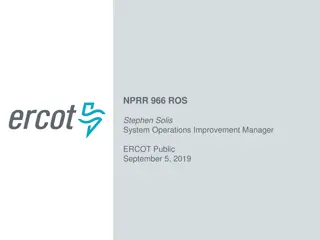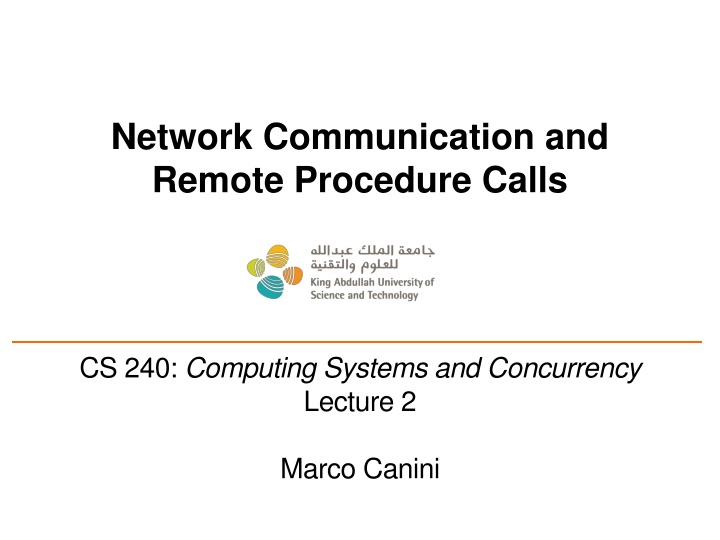
Network Communication in Distributed Systems
Explore the essentials of network communication, remote procedure calls, and the challenges involved in ensuring communication among processes on different computers. Learn how layering in the Internet plays a crucial role in facilitating end-to-end communication between hosts. Discover the significance of logical communication between layers for seamless data exchange.
Download Presentation

Please find below an Image/Link to download the presentation.
The content on the website is provided AS IS for your information and personal use only. It may not be sold, licensed, or shared on other websites without obtaining consent from the author. If you encounter any issues during the download, it is possible that the publisher has removed the file from their server.
You are allowed to download the files provided on this website for personal or commercial use, subject to the condition that they are used lawfully. All files are the property of their respective owners.
The content on the website is provided AS IS for your information and personal use only. It may not be sold, licensed, or shared on other websites without obtaining consent from the author.
E N D
Presentation Transcript
Network Communication and Remote Procedure Calls CS 240: Computing Systems and Concurrency Lecture 2 Marco Canini
Distributed Systems, What? 1)Multiple computers 2)Connected by a network 3)Doing something together 2
Todays outline How can processes on different cooperating computers communicate with each other over the network? 1. Network Communication 2. Remote Procedure Call (RPC) 3
The problem of communication Process on HostA wants to talk to process on Host B A and B must agree on the meaning of the bits being sent and received at many different levels, including: How many volts is a 0 bit, a 1 bit? How does receiver know which is the last bit? How many bits long is a number? 4
The problem of communication HTTP FTP Skype SSH Applications Transmission media Coaxial cable Fiber optic Wi-Fi Re-implement every application for every new underlying transmission medium? Change every application on any change to an underlying transmission medium? No! But how does the Internet design avoid this?
Solution: Layering Applications HTTP FTP Skype SSH Intermediate layers Transmission media Coaxial cable Fiber optic Wi-Fi Intermediate layers provide a set of abstractions for applications and media New applications or media need only implement for intermediate layer s interface
Layering in the Internet Transport: Provide end-to-end communication between processes on different hosts Applications Network: Deliver packets to destinations on other (heterogeneous) networks Transport layer Network layer Link layer Physical layer Link: Enables end hosts to exchange atomic messages with each other Host Physical: Moves bits between two hosts connected by a physical link 7
Logical communication between layers How to forge agreement on the meaning of the bits exchanged between two hosts? Protocol: Rules that governs the format, contents, and meaning of messages Each layer on a host interacts with its peerhost s corresponding layer via the protocol interface Application Transport Network Link Physical Host A Application Transport Network Link Physical Host B Network Link Physical Router 8
Physical communication Communication goes down to the physical network Then from network peer to peer Then up to the relevant application Application Transport Network Link Physical Host A Application Transport Network Link Physical Host B Network Link Physical Router 9
Communication between peers How do peer protocols coordinate with each other? Layer attaches its own header (H) to communicate with peer Higher layers headers, data encapsulated inside message Lower layers don t generally inspect higher layers headers Application Application message Transport-layer message body H Transport Network-layer datagram body Network H 10
Network socket-based communication Socket: The interface the OS provides to the network Provides inter-process explicit message exchange Can build distributed systems atop sockets: send(), recv() e.g.: put(key,value) message Application layer Application layer Process Process Socket Socket Transport layer Network layer Link layer Physical layer Transport layer Network layer Link layer Physical layer Host A Host B 11
// Create a socket for the client if ((sockfd = socket (AF_INET, SOCK_STREAM, 0)) < 0) { perror( Socket creation"); exit(2); } // Set server address and port memset(&servaddr, 0, sizeof(servaddr)); servaddr.sin_family = AF_INET; servaddr.sin_addr.s_addr = inet_addr(argv[1]); servaddr.sin_port = htons(SERV_PORT); // to big-endian // Establish TCP connection if (connect(sockfd, (struct sockaddr *) &servaddr, sizeof(servaddr)) < 0) { perror( Connect to server"); exit(3); } // Transmit the data over the TCP connection send(sockfd, buf, strlen(buf), 0); 12
Network sockets: not great Principle of transparency: Hide that resource is physically distributed across multiple computers Access resource same way as locally Users can t tell where resource is physically located Network sockets provide apps with point-to-point communication between processes Sockets don t provide transparency Also, lots to deal with, have to worry a lot about the network How to separate different requests on the same connection? How to write bytes to the network / read bytes from the network? What if Host A s process is in Go and Host B s process is in C++? What to do with those bytes? 13
Solution: Another layer! Application layer Application layer Process Process RPC layer RPC layer Socket Socket Transport layer Network layer Link layer Physical layer Transport layer Network layer Link layer Physical layer Host A Host B 14
Todays outline 1. Network Communication 2. Remote Procedure Call (RPC) 15
Why RPC? The typical programmer is trained to write single-threaded code that runs in one place Goal: Easy-to-program network communication that makes client-server communication transparent Retains the feel of writing centralized code Programmer needn t think about the network 16
Everyone uses RPCs Course programming assignments use RPC Google gRPC Facebook/Apache Thrift Twitter Finagle 17
Whats the goal of RPC? Within a single program, running in a single process, recall the well-known notion of a procedure call: Caller pushes arguments onto stack, jumps to address of callee function Callee reads arguments from stack, executes, puts return value in register, returns to next instruction in caller RPC s Goal: To make communication appear like a local procedure call: transparency for procedure calls 18
Historical note Seems obvious in retrospect, but RPC was only invented in the 80s See Birrell & Nelson, Implementing Remote Procedure Call ... or Bruce Nelson, Ph.D. Thesis, Carnegie Mellon University: Remote Procedure Call., 1981 19
RPC issues 1. Heterogeneity Client needs to rendezvous with the server Server must dispatch to the required function What if server is different type of machine? 2. Failure What if messages get dropped? What if client, server, or network fails? 3. Performance Procedure call takes 10 cycles 3 ns RPC in a data center takes 10 s (103 slower) In the wide area, typically 106 slower 20
Problem: Differences in data representation Not an issue for local procedure call For a remote procedure call, a remote machine may: Run process written in a different language Represent data types using different sizes Use a different byte ordering (endianness) Represent floating point numbers differently Have different data alignment requirements e.g., 4-byte type begins only on 4-byte memory boundary 21
Solution: Interface Description Language Mechanism to pass procedure parameters and return values in a machine-independent way Programmer may write an interface description in the IDL Defines API for procedure calls: names, parameter/return types Then runs an IDL compiler which generates: Code to marshal (convert) native data types into machine- independent byte streams And vice-versa, called unmarshaling Client stub: Forwards local procedure call as a request to server Server stub: Dispatches RPC to its implementation 22
A day in the life of an RPC 1. Client calls stub function (pushes params onto stack) Client machine Client process k = add(3, 5) Client stub (RPC library) 23
A day in the life of an RPC 1. Client calls stub function (pushes params onto stack) 2. Stub marshals parameters to a network message Client machine Client process k = add(3, 5) Client stub (RPC library) proc: add | int: 3 | int: 5 Client OS 24
A day in the life of an RPC 2. Stub marshals parameters to a network message 3. OS sends a network message to the server Client machine Server machine Client process k = add(3, 5) Client stub (RPC library) Client OS proc: add | int: 3 | int: 5 Server OS 25
A day in the life of an RPC 3. OS sends a network message to the server 4. Server OS receives message, sends it up to stub Client machine Server machine Client process k = add(3, 5) Client stub (RPC library) Server stub (RPC library) Client OS Server OS proc: add | int: 3 | int: 5 26
A day in the life of an RPC 4. Server OS receives message, sends it up to stub 5. Server stub unmarshals params, calls server function Client machine Server machine Client process Server process Implementation of add k = add(3, 5) Client stub (RPC library) Server stub (RPC library) proc: add | int: 3 | int: 5 Client OS Server OS 27
A day in the life of an RPC 5. Server stub unmarshals params, calls server function 6. Server function runs, returns a value Client machine Server machine Client process Server process 8 k = add(3, 5) add(3, 5) Client stub (RPC library) Server stub (RPC library) Client OS Server OS 28
A day in the life of an RPC 6. Server function runs, returns a value 7. Server stub marshals the return value, sends msg Client machine Server machine Client process Server process 8 add(3, 5) k = add(3, 5) Client stub (RPC library) Server stub (RPC library) Result | int: 8 Client OS Server OS 29
A day in the life of an RPC 7. Server stub marshals the return value, sends msg 8. Server OS sends the reply back across the network Client machine Server machine Client process Server process 8 add(3, 5) k = add(3, 5) Client stub (RPC library) Server stub (RPC library) Client OS Server OS Result | int: 8 30
A day in the life of an RPC 8. Server OS sends the reply back across the network 9. Client OS receives the reply and passes up to stub Client machine Server machine Client process Server process 8 add(3, 5) k = add(3, 5) Client stub (RPC library) Server stub (RPC library) Client OS Server OS Result | int: 8 31
A day in the life of an RPC 9. Client OS receives the reply and passes up to stub 10. Client stub unmarshals return value, returns to client Client machine Server machine Client process Server process 8 add(3, 5) k 8 Client stub (RPC library) Result | int: 8 Server stub (RPC library) Client OS Server OS 32
The server stub is really two parts Dispatcher Receives a client s RPC request Identifies appropriate server-side method to invoke Skeleton Unmarshals parameters to server-native types Calls the local server procedure Marshals the response, sends it back to the dispatcher All this is hidden from the programmer Dispatcher and skeleton may be integrated Depends on implementation 33
Todays outline 1. Network Communication 2. Remote Procedure Call (RPC) Heterogeneity use IDL w/ compiler Failure 34
What could possibly go wrong? 1. Client may crash and reboot 2. Packets may be dropped Some individual packet loss in the Internet Broken routing results in many lost packets 3. Server may crashand reboot 4. Network or server might just be very slow All these may look the same to the client 35
Failures, from clients perspective Client Server Time The cause of the failure is hidden from the client! 36
At-Least-Once scheme Simplest scheme for handling failures 1. Client stub waits for a response, for a while Response takes the form of an acknowledgement message from the server stub 2. If no response arrives after a fixed timeout time period, then client stub re-sends the request Repeat the above a few times Still no response? Return an error to the application 37
At-Least-Once and side effects Client sends a debit $10 from bank account RPC Client Server (debit $10) (debit $10) Time 38
At-Least-Once and writes put(x, value), then get(x): expect answer to be value put(x,10) put(x,20) Client Server Idempotent operation is one that has no additional effect if it is called more than once with the same input parameters x 10 Idempotent requests are safe to re-execute, causing no side effects Time 39
At-Least-Once and writes put(x, value), then get(x): expect answer to be value put(x,10) put(x,20) Client Server x 10 x 20 get(x)? x=20 Time 40
At-Least-Once and writes Consider a client storing key-value pairs in a database put(x, value), then get(x): expect answer to be value put(x,10) put(x,20) Client Server x 10 x 20 get(x)? x=20 x 10 Time 41
So is At-Least-Once ever okay? Yes: If they are read-only operations with no side effects e.g., read a key s value in a database Yes: If the application has its own functionality to cope with duplication and reordering You will need this in Assignments 3 onwards 42
At-Most-Once scheme Idea: server RPC stub detects duplicate requests Returns previous reply instead of re-running handler How to detect a duplicate request? Test: Server sees same function, same arguments twice No! Sometimes applications legitimately submit the same function with same augments, twice in a row 43
At-Most-Once scheme How to detect a duplicate request? Client stub includes unique transaction ID (xid) with each one of its RPC requests Client stub uses same xid for retransmitted requests At-Most-Once Server if seen[xid]: retval = old[xid] else: retval = handler() old[xid] = retval seen[xid] = true return retval 44
At Most Once: Providing unique XIDs How to ensure that the xid is unique? 1. Combine a unique client ID (e.g., IP address) with the current time of day 2. Combine unique client ID with a sequence number Suppose the client crashes and restarts. Can it reuse the same client ID? 3. Big random number (probabilistic, not certain guarantee) 45
At-Most-Once: Discarding server state Problem: seenandold arrays will grow without bound Observation: By construction, when the client gets a response to a particular xid, it will never re-send it Client could tellserver I m done with xid x delete it Have to tell the server about each and every retired xid Could piggyback on subsequent requests Significant overhead if many RPCs are in flight, in parallel 46
At-Most-Once: Discarding server state Problem: seenandold arrays will grow without bound Suppose xid = unique client id, sequence no. e.g. 42, 1000 , 42, 1001 , 42, 1002 Client includes seen all replies X with every RPC Much like TCP sequence numbers, acks How does the client know that the server received the information about retired RPCs? Idea: Each one of these is cumulative: later seen messages subsume earlier ones 47
At-Most-Once: Concurrent requests Problem: How to handle a duplicate request while the original is still executing? Server doesn t know reply yet. Also, we don t want to run the procedure twice Idea: Add a pending flag per executing RPC Server waits for the procedure to finish, or ignores 48
At Most Once: Server crash and restart Problem: Server may crash and restart Does server need to write its state (seen, old) to disk? Yes! On server crash and restart: If old[], seen[] arrays are only in memory: Server will forget, accept duplicate requests 49
Exactly-once? Need retransmission of at least once scheme Plus the duplicate filtering of at most once scheme To survive client crashes, client needs to record pending RPCs on disk So it can replay them with the same unique identifier Plus story for making server reliable Even if server fails, it needs to continue with full state To survive server crashes, server should log to disk results of completed RPCs (to suppress duplicates) 50

